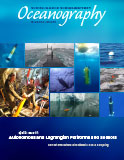First Paragraph
Internal tides are an important mechanism in the cascade of kinetic energy within the ocean that ranges from large-scale surface tides to small-scale turbulent mixing. Through this cascade, internal tides contribute to the global mixing budget and drive vertical nutrient fluxes that enhance primary productivity in nutrient-limited surface waters. Although internal tides are a common phenomenon over continental shelves and slopes, as they are generated by tidal currents across sloping topography (e.g., shelf breaks, submarine ridges, canyons, and seamounts), directly observing them in these regions can be a challenge because intense commercial fishing activity increases the risk of instrument loss. Internal tide energy flux, an important diagnostic for the study of energy pathways in the ocean, requires repeated full-depth measurements of both potential density and horizontal current velocity over at least a tidal cycle (several weeks to resolve the internal spring-neap cycle). Typically, these measurements are made using an acoustic Doppler current profiler (ADCP) and a string of conductivity-temperature loggers on a mooring line, or a moored profiler with a CTD and a current meter. These full-depth moorings are vulnerable to being “fished-out” by demersal and pelagic trawling.

